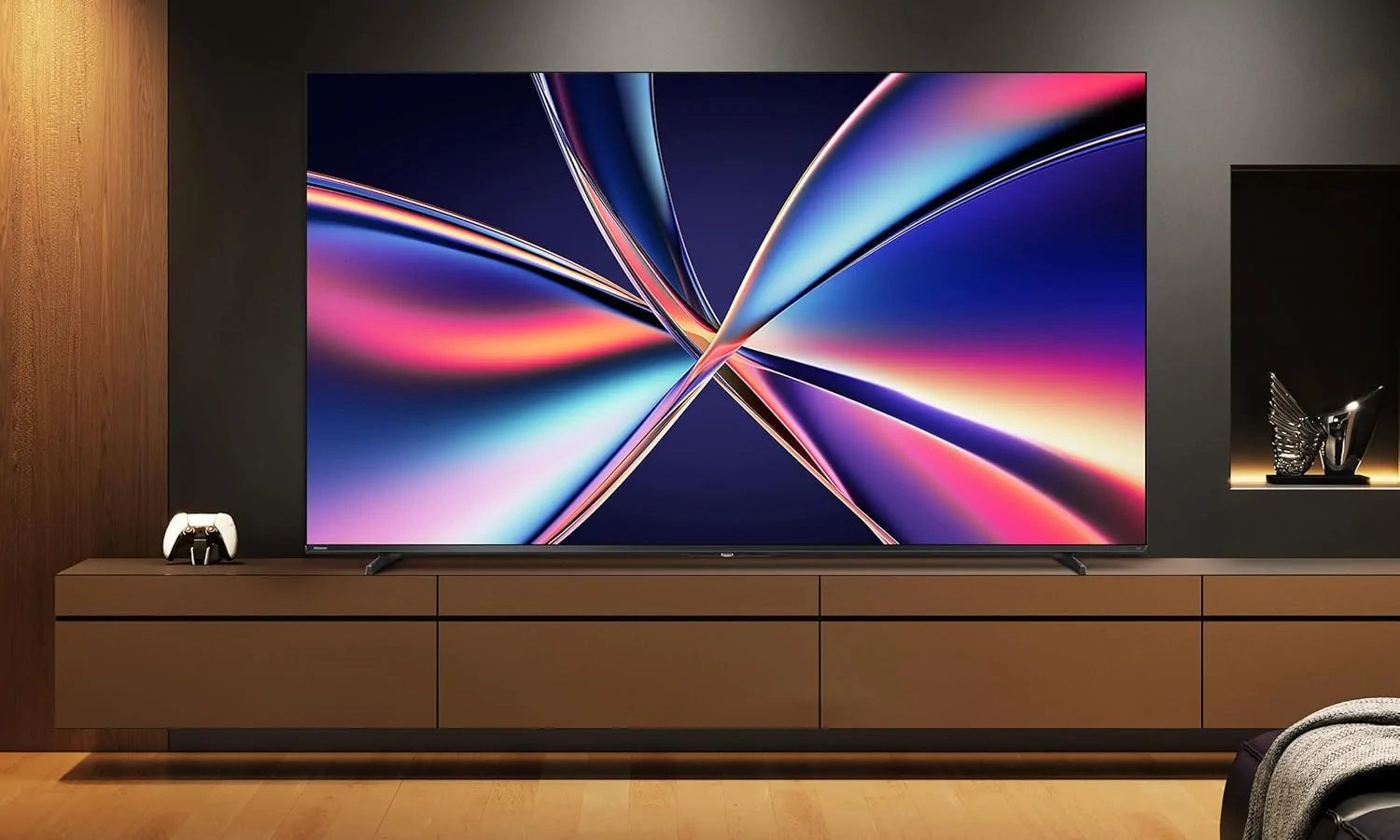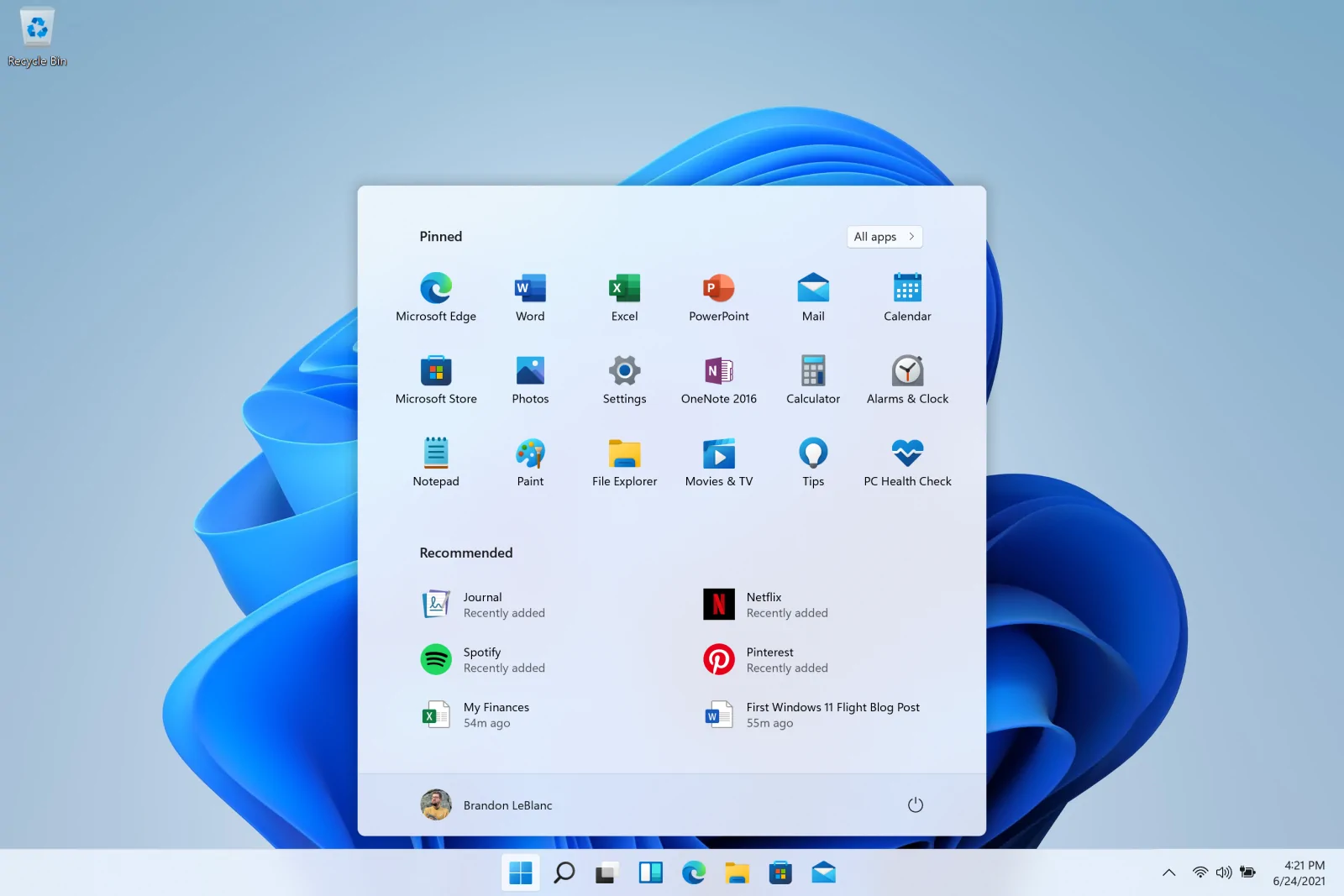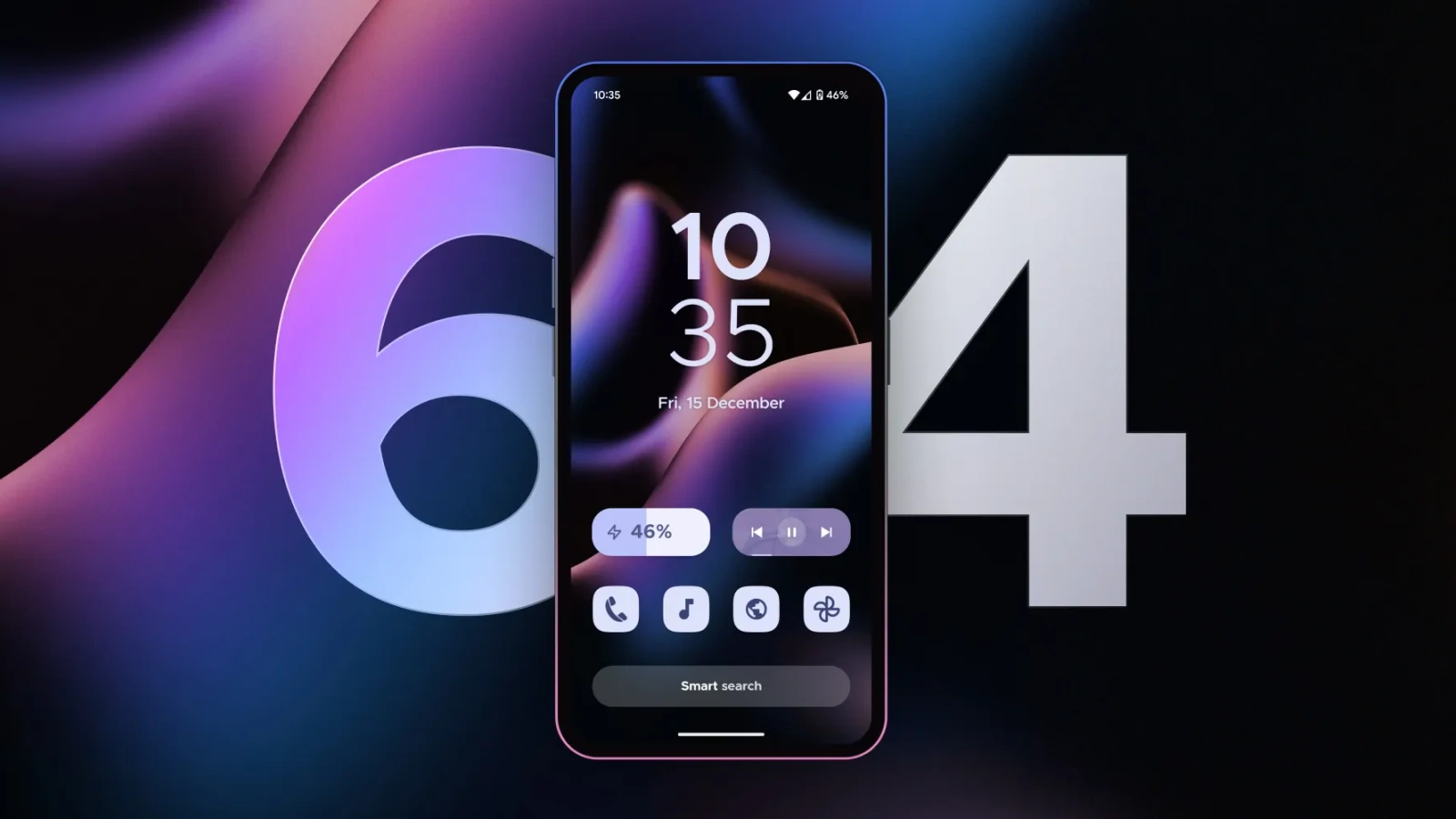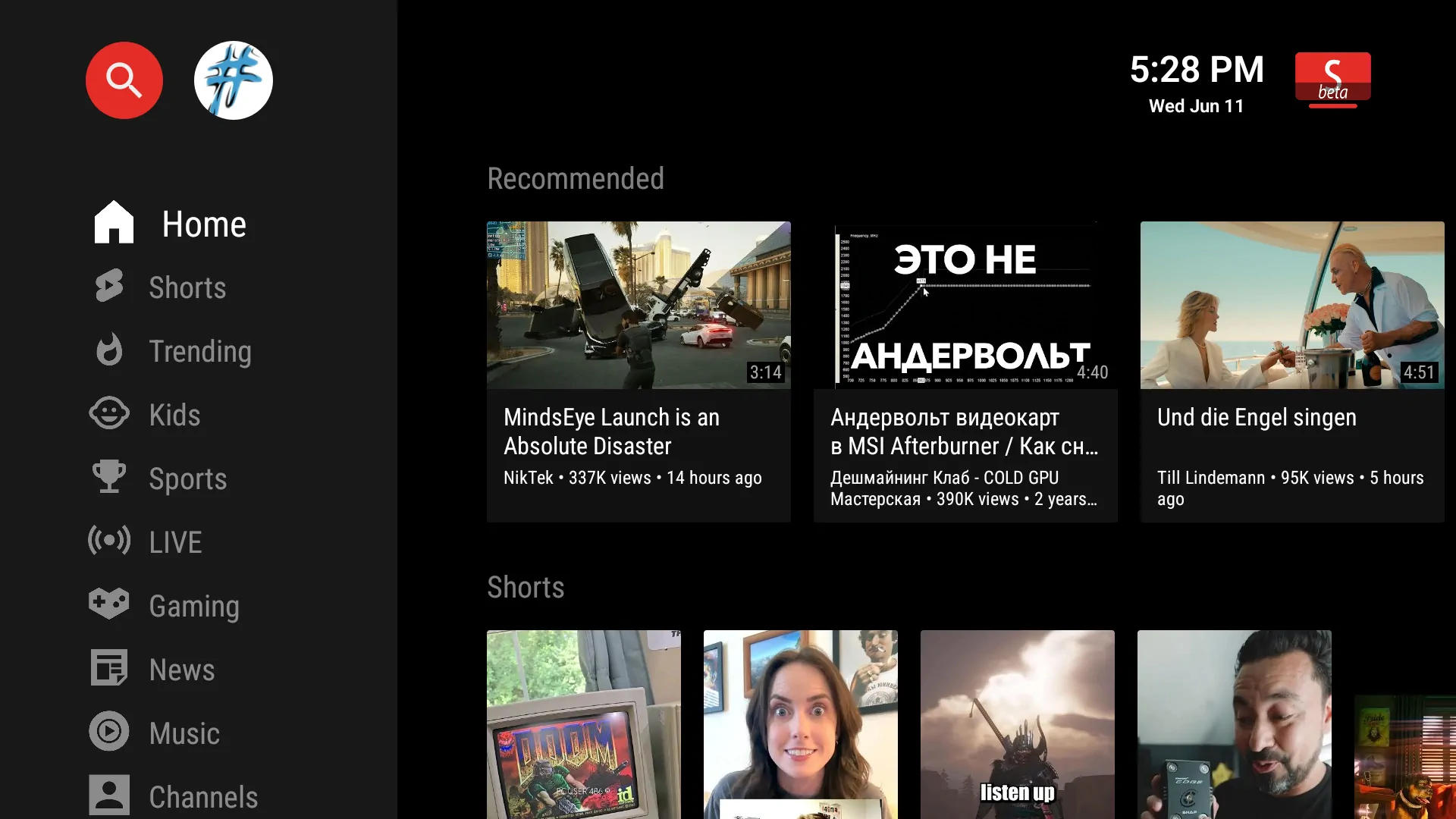Looking for the best cheap QLED TVs in 2025? We’ve rounded up top picks under $500 from TCL, Hisense, and Insignia—featuring Dolby Vision, Mini‑LED, and vibrant colors for movies, gaming, and streaming.
The living room TV is still the centerpiece of home entertainment, and in 2025 you don’t need to spend thousands to get a premium experience. Affordable QLED models now bring features once reserved for high‑end sets—punchy colors, strong contrast, and advanced HDR—into the sub‑$500 range.
If you’re shopping for a 55‑ or 65‑inch screen on a budget, brands like TCL, Hisense, and Insignia are leading the charge with models that easily outperform the basic LED TVs of just a few years ago. In this guide, we’ve selected six of the best budget QLEDs available on Amazon and other retailers, based on expert testing, user reviews, and updated specs.
These TVs aren’t just about saving money—they balance picture quality, smart features, and versatility for everything from Netflix binges to casual console gaming. Imagine watching a movie with deep blacks and explosive highlights, or playing your favorite game with smooth motion and vivid colors—all for less than the cost of a weekend getaway.
That’s the appeal of cheap QLEDs in 2025: they combine the efficiency of LED panels with quantum dot technology, delivering a wider color gamut and higher brightness than OLED in bright rooms. Throughout this article, we’ll break down each model’s strengths, key specs, and buying tips so you can pick the right one for your setup.
🔬 QLED vs. OLED: What’s the Difference?
QLED (Quantum Dot LED) builds on traditional LED/LCD panels by adding a layer of quantum dots—tiny particles that filter light to produce richer, more accurate colors. Paired with LED or Mini‑LED backlighting, QLED TVs excel at brightness and vibrancy, making them great for daytime viewing or well‑lit rooms. Brands like Samsung, TCL, and Hisense use QLED to deliver impressive HDR without the premium price tag.
OLED (Organic Light‑Emitting Diode) works differently: each pixel emits its own light, allowing for perfect blacks and infinite contrast. This makes OLED unbeatable for dark‑room movie nights or cinematic accuracy. The trade‑offs? OLED sets are still pricier (rarely under $800 in 2025), less bright in sunlit rooms, and can be vulnerable to image retention with static content.
For most shoppers under $500, QLED is the smarter buy—offering durability, brightness, and strong all‑around performance. OLED remains the choice for purists chasing absolute picture quality, while newer QD‑OLED hybrids aim to merge the best of both worlds at higher price points.
🔝 Best Cheap QLED TVs of 2025
TCL 55QM6K (2025): Mini‑LED performance at a budget price
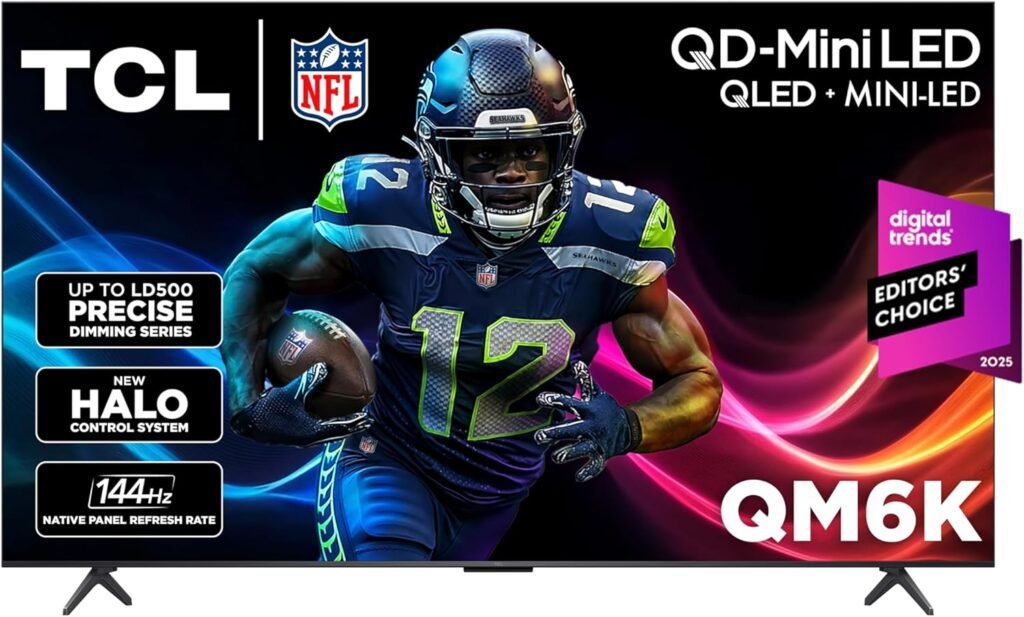
If you want a TV that feels close to premium without crossing the $500 line, the TCL 55QM6K is one of the strongest contenders this year. It combines Quantum Dot color with a Mini‑LED backlight, delivering contrast and brightness levels that rival sets costing twice as much.
Sports look crisp, with fast motion handled cleanly, while action scenes benefit from precise local dimming that keeps shadows detailed without washing out highlights. TCL’s AIPQ processor analyzes every frame to optimize brightness and color on the fly, and the built‑in Onkyo audio system with a subwoofer adds punchy sound that makes a soundbar optional for smaller rooms.
For gamers, the 144Hz native refresh rate (up to 240Hz with Game Accelerator) and VRR support keep gameplay smooth and responsive. Input lag is impressively low, making it a solid pick for both casual and competitive play. The only drawback is the VA panel’s limited viewing angles—colors fade if you’re sitting far off to the side—but for most living rooms, it’s a non‑issue.
Key Specs:
- Size: 55 inches
- Resolution: 4K UHD
- Backlight: QD‑Mini LED with Full Array Local Dimming
- Refresh Rate: 144Hz native (up to 240Hz with Game Accelerator)
- OS: Google TV
- Highlights: Dolby Vision, HDR10+, Dolby Atmos, AIPQ Engine, GameBar, Art Mode
Hisense 55QD7QF (2025): Mini‑LED value with Fire TV built‑in
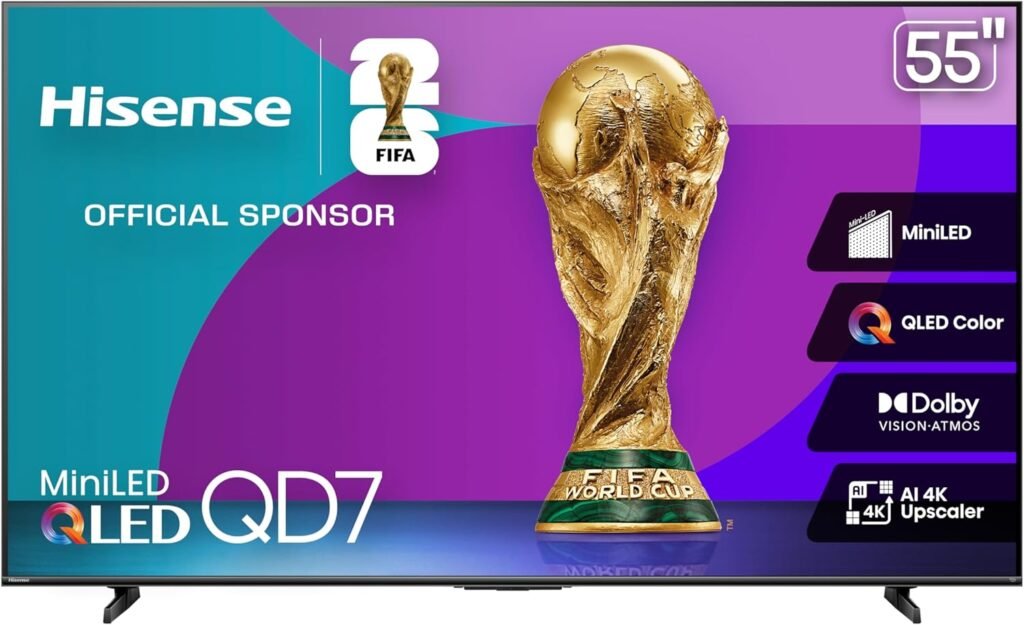
The Hisense 55QD7QF is another standout in the sub‑$500 category, offering Mini‑LED backlighting with hundreds of tiny LEDs for deeper blacks and brighter highlights. Movies like Dune look fantastic, with shadow detail preserved and bright elements popping without distracting halos.
Its integration with Fire TV makes it especially appealing for Amazon users: Alexa voice control, personalized recommendations, and seamless access to Prime Video are all built in. The AI upscaler does a great job cleaning up lower‑resolution content, while Filmmaker Mode ensures movies play back as the director intended.
For gaming, the Game Mode Plus with VRR and low latency keeps console play smooth, though the 60Hz panel won’t satisfy hardcore competitive gamers. Sound is handled by a 20W Dolby Atmos system, which is fine for everyday use, though a soundbar is recommended for larger rooms.
Some users note occasional software hiccups, but these are usually fixed with a quick restart. Overall, the QD7QF delivers excellent everyday performance at a price that’s hard to beat.
Key Specs:
- Size: 55 inches
- Resolution: 4K UHD
- Backlight: Mini‑LED with Full Array Local Dimming (up to 600 nits)
- Refresh Rate: 60Hz native (Motion Rate 240 with VRR)
- OS: Fire TV
- Highlights: Dolby Vision, HDR10+, Dolby Atmos, AI 4K Upscaler, MEMC, Game Mode Plus, Filmmaker Mode
Hisense 55E6QF (2025): Affordable cinema experience at home
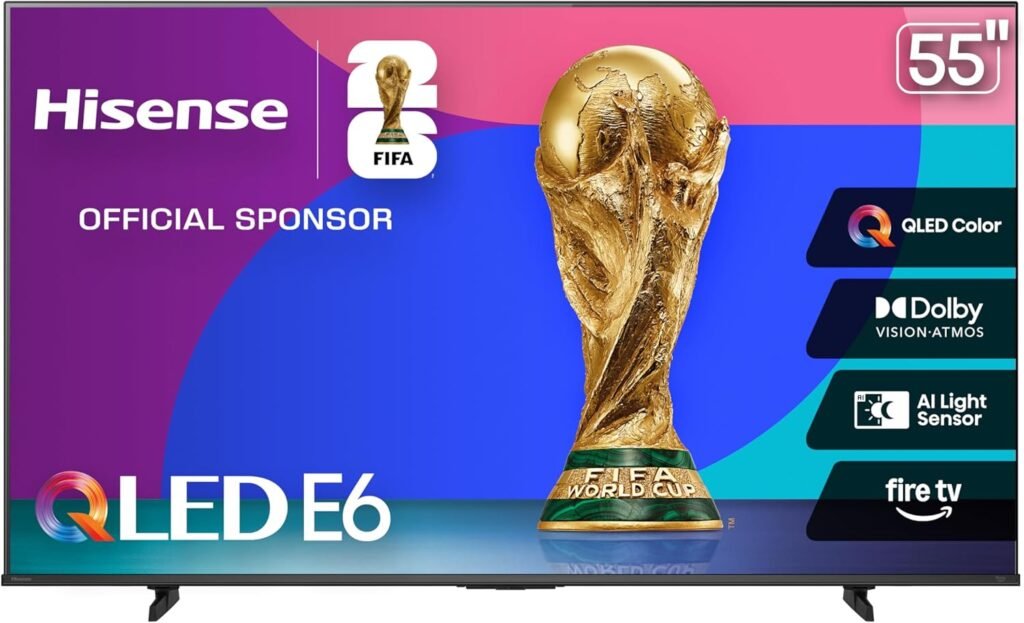
If your priority is movie nights and streaming marathons, the Hisense 55E6QF is one of the best values under $500. This QLED model is tuned for cinematic performance, with Quantum Dot color that makes landscapes pop and night scenes look more convincing than on standard LED sets.
With Fire TV built in, it’s easy to jump between Netflix, Disney+, or Prime Video, and Alexa voice control keeps navigation simple. The Filmmaker Mode ensures movies play back as intended, while the AI Light Sensor automatically adjusts brightness to match your room’s lighting.
For casual gamers, the Game Mode Plus with ALLM keeps input lag low, though the 60Hz panel won’t satisfy competitive players. The AI 4K Upscaler is a nice touch, sharpening older broadcasts and low‑res streams. Sound is Dolby Atmos‑ready, but the built‑in speakers can feel flat in larger rooms—pairing it with a soundbar is recommended.
Key Specs:
- Size: 55 inches
- Resolution: 4K UHD
- Backlight: Direct‑Lit LED
- Refresh Rate: 60Hz native (Motion Rate 120)
- OS: Fire TV
- Highlights: Dolby Vision, HDR10+ Adaptive, Dolby Atmos, AI 4K Upscaler, MEMC, Filmmaker Mode, AI Light Sensor
Insignia 55QF (2025): The cheapest way into QLED
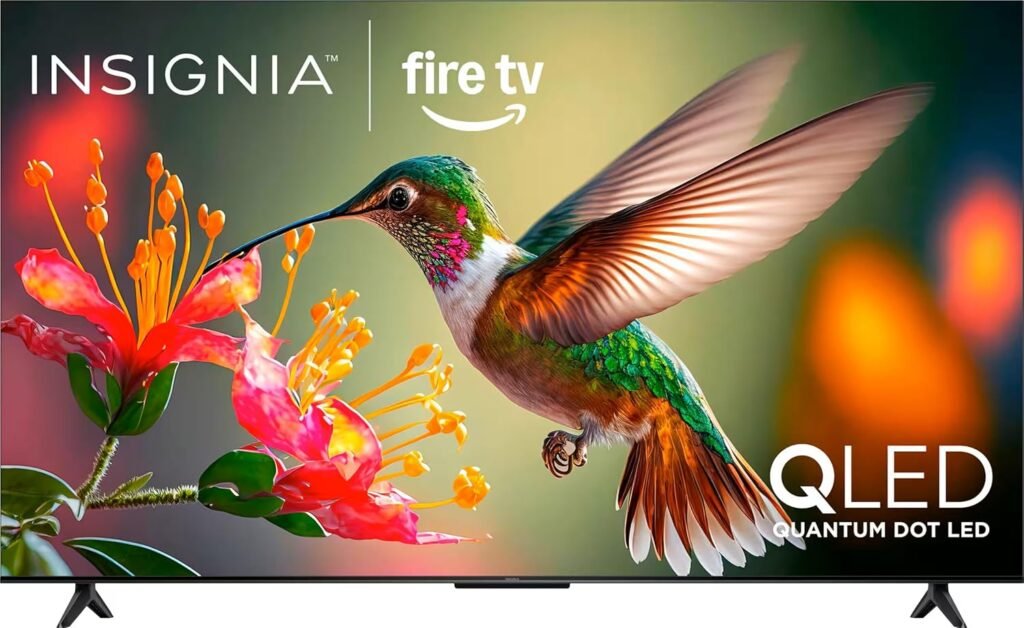
For shoppers who just want the most affordable entry point into QLED, the Insignia 55QF delivers more than you’d expect for under $250. It doesn’t aim to compete with high‑end sets, but its Quantum Dot panel with Direct LED backlight produces richer colors and better uniformity than basic LED TVs.
The design is slim and borderless, giving it a modern look that works in bedrooms or secondary living spaces. With Fire TV and Alexa built in, you can launch apps like Hulu or YouTube with a simple voice command.
There are trade‑offs: no local dimming means some blooming in dark scenes, and the 60Hz refresh rate is standard. Still, support for Dolby Vision boosts HDR content, and Dolby Atmos audio provides clear dialogue and decent immersion for everyday use.
Buyers highlight its easy setup and solid streaming performance, though HDMI ports can be finicky and viewing angles aren’t ideal for large groups. But at this price, the Insignia 55QF is a budget gem that makes QLED accessible to almost anyone.
Key Specs:
- Size: 55 inches
- Resolution: 4K UHD
- Backlight: Direct‑Lit LED
- Refresh Rate: 60Hz
- OS: Fire TV
- Highlights: Dolby Vision, HDR10, Dolby Atmos, Quantum Dot Color, Alexa Voice Remote
Hisense 65QD6QF (2025): Big‑screen QLED for less
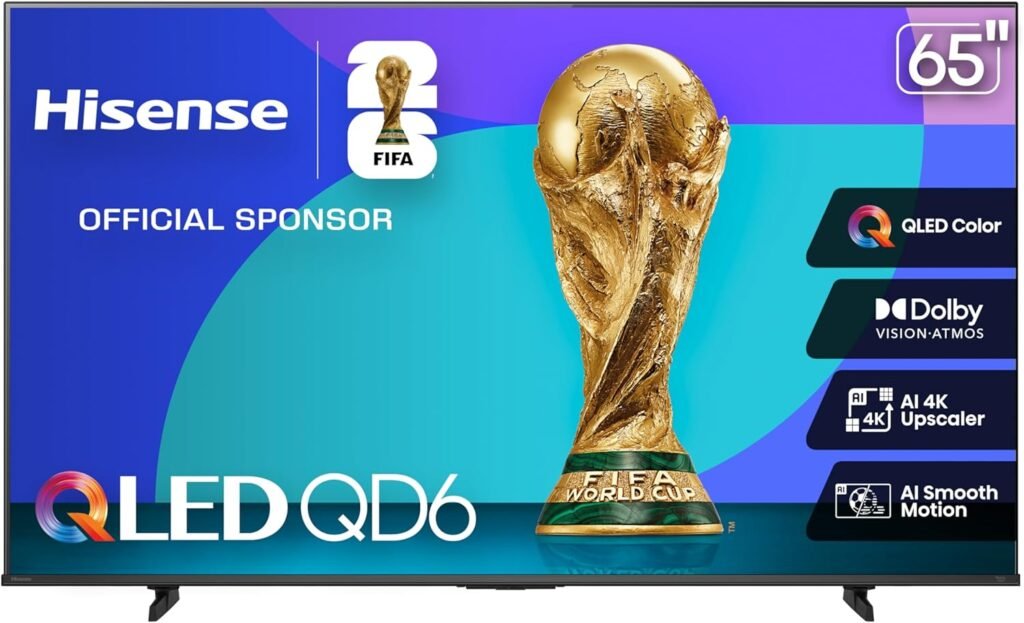
If you want size and value in the same package, the Hisense 65QD6QF is one of the best large‑format QLEDs under $500. At 65 inches, it delivers an immersive viewing experience with Quantum Dot color that makes nature documentaries, sports, and action movies pop.
The built‑in AI 4K Upscaler breathes new life into older broadcasts, while the AI Sports Mode sharpens fast motion so games look crisp and fluid. For gamers, the Game Mode Plus with VRR and ALLM keeps input lag low and gameplay smooth on consoles like Xbox and PlayStation.
Contrast is solid for the price (rated at 4000:1), and Dolby Vision HDR adds extra punch to highlights and shadow detail. The only weak spot is the audio: while it supports Dolby Atmos, the built‑in speakers can feel thin in larger rooms, so a soundbar is recommended.
Key Specs:
- Size: 65 inches
- Resolution: 4K UHD
- Backlight: Direct‑Lit LED
- Refresh Rate: 60Hz native (Motion Rate 120 with VRR)
- OS: Fire TV
- Highlights: Dolby Vision, HDR10+, Dolby Atmos, AI 4K Upscaler, MEMC, Filmmaker Mode, AI Sports Mode, Game Mode Plus
Fire TV Omni QLED 55″ (2022–2023, still a deal in 2025)
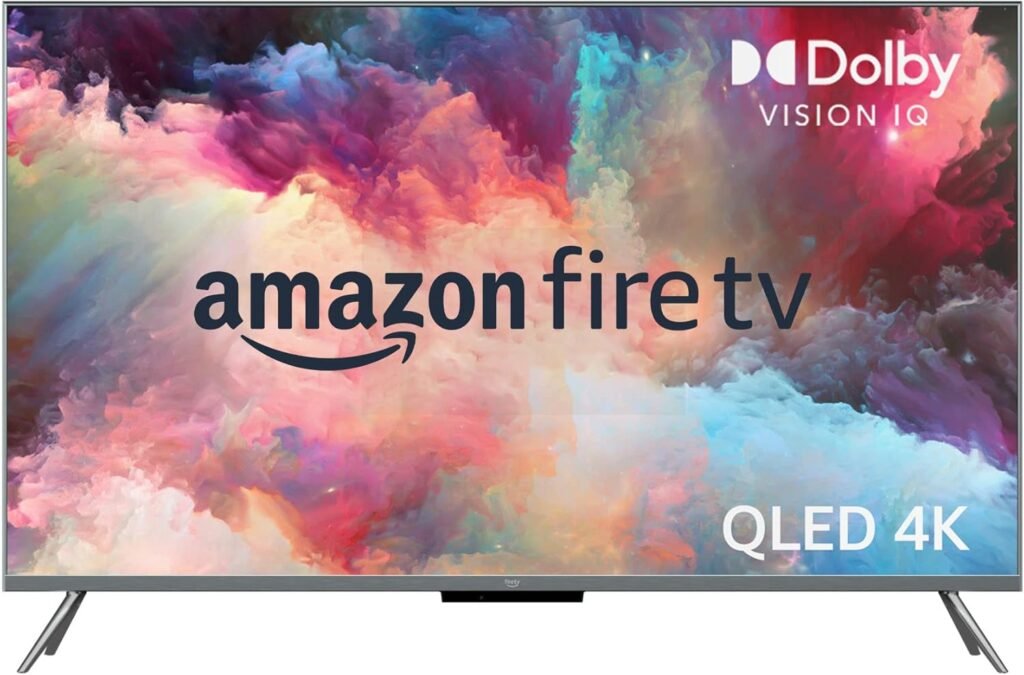
Even though it launched a couple of years ago, the Fire TV Omni QLED 55″ remains a smart buy in 2025 thanks to frequent discounts and its seamless integration with Amazon’s ecosystem.
This set combines Quantum Dots with Full Array Local Dimming (64 zones) for strong HDR performance, whether you’re watching a moody thriller or a bright nature documentary. Its Ambient Experience mode turns the screen into a digital canvas for artwork or personal photos when not in use, adding a decorative touch to your living space.
With hands‑free Alexa, you can control apps, adjust settings, or manage smart home devices without picking up the remote. Dolby Vision IQ automatically adjusts picture quality based on your room’s lighting, keeping colors accurate day or night.
For casual gaming, the ALLM mode reduces input lag, though the 60Hz panel without VRR won’t satisfy competitive players. Sound is handled by a 20W Dolby Atmos system—fine for everyday use, but a soundbar is recommended for bigger rooms.
Key Specs:
- Size: 55 inches
- Resolution: 4K UHD
- Backlight: Full Array Local Dimming (64 zones)
- Refresh Rate: 60Hz
- OS: Fire TV
- Highlights: Dolby Vision IQ, HDR10+ Adaptive, Dolby Atmos, Ambient Experience, Hands‑free Alexa, ALLM
🔍 What to Look for in a Cheap QLED TV
Shopping for a QLED TV under $500 can feel overwhelming, but focusing on a few key specs makes the process much easier. Here’s what really matters when you’re trying to balance picture quality, smart features, and price.
💡 Backlighting: Direct Lit or Full Array beats Edge Lit
Budget TVs typically use one of three backlighting systems:
- Edge Lit: LEDs sit only along the edges of the panel. It’s the cheapest option, but blacks look gray and bright objects can create halos.
- Direct Lit: LEDs are spread across the back of the screen, giving better uniformity and contrast than Edge Lit.
- Full Array Local Dimming (FALD) / Mini‑LED: The best option in this price range. The screen is divided into zones that dim or brighten independently, producing deeper blacks and more impactful highlights.
If you can, aim for FALD or Mini‑LED (like TCL’s QM6K or Hisense’s QD7). They make a noticeable difference in movies and games.
🎨 Panel Tech: QLED as the baseline, Mini‑LED as the upgrade
All QLED TVs use quantum dots to boost color and brightness, making them a big step up from standard LED. Within the budget category, Mini‑LED is the premium upgrade, offering more precise control of contrast. OLED still wins on absolute black levels, but you won’t find it under $800—so QLED is the sweet spot for affordable performance.
🌈 HDR Support: Dolby Vision is the one to get
HDR (High Dynamic Range) makes colors richer and contrast sharper, but not all formats are equal. Dolby Vision adjusts brightness and color scene by scene, giving it an edge over basic HDR10. Some sets also support HDR10+ Adaptive, which tweaks the picture based on your room’s lighting. At minimum, look for Dolby Vision if you want streaming and gaming to shine.
🔊 Audio: Dolby Atmos helps, but add a soundbar if you can
Even cheap QLEDs now support Dolby Atmos, which adds a sense of height and immersion to sound. But built‑in speakers (usually 20–40W) can feel thin in larger rooms. If you want a real upgrade, make sure the TV has HDMI eARC so you can connect a soundbar or receiver without losing audio quality.
🎮 Refresh Rate & Gaming: 60Hz is fine, VRR is better
Most budget QLEDs run at 60Hz, which is fine for casual gaming and everyday use. But if you own a PS5 or Xbox Series X, look for Variable Refresh Rate (VRR) and Auto Low Latency Mode (ALLM)—they reduce lag and screen tearing. TCL’s QM6K even offers 144Hz, which is rare at this price.
📱 Smart Platform: Fire TV vs. Google TV
The operating system matters more than you think:
- Fire TV (Hisense, Insignia, Fire TV Omni) is perfect if you’re deep in Amazon’s ecosystem, with Alexa voice control and Prime Video front and center.
- Google TV (TCL, some Hisense models) offers broader app support, Chromecast built‑in, and better integration with Android and iOS devices.
Both are fast and easy to use—pick the one that fits your digital life.
📏 Size & Brightness: 55–65 inches is the sweet spot
For most living rooms, 55 to 65 inches is ideal at a viewing distance of 7–10 feet. Brightness in the 350–600 nit range is enough for daytime viewing. Some models also include light sensors that auto‑adjust brightness to your room, saving energy and improving comfort.
🔌 Connectivity: Don’t skimp on HDMI ports
Look for at least three HDMI ports, with one supporting eARC for audio. If you’re a gamer, HDMI 2.1 is a must for 4K at 120Hz and VRR (available on models like the TCL QM6K and Hisense QD7). Extras like Wi‑Fi 6 and Bluetooth are nice to have for smoother streaming and wireless headphones.
✅ Bottom line: When buying a cheap QLED, prioritize better backlighting (FALD or Mini‑LED), Dolby Vision HDR, and gaming features like VRR/ALLM. Pair that with the smart platform you prefer, and you’ll get a TV that feels premium without the premium price.
🏁 Conclusion
The good news for 2025 is that you don’t need to spend a fortune to get a big‑screen TV with premium features. Affordable QLED models now deliver vibrant colors, solid contrast, Dolby Vision HDR, and smooth smart platforms — all for under $500.
Among the options we tested, the TCL 55QM6K stands out as the best all‑around pick. With Mini‑LED backlighting, 144Hz refresh rate, and Dolby Atmos audio, it punches well above its price class, making it a top choice for both streaming and gaming.
That said, there’s no single “best” for everyone:
- Hisense QD7 is a great balance of sports, movies, and Fire TV integration.
- Hisense E6 is tuned for cinema lovers who want Dolby Vision and adaptive brightness.
- Insignia QF is the cheapest way to step into QLED, perfect for secondary rooms or tight budgets.
- Hisense QD6 offers a massive 65‑inch screen at a price few can match.
- Fire TV Omni QLED remains a smart buy on sale, especially if you’re already invested in Amazon’s ecosystem.
Bottom line: whether you’re a movie buff, a casual gamer, or just want a bigger screen for family nights, there’s a budget QLED in 2025 that fits the bill.
❓ Frequently Asked Questions (FAQ)
What’s the difference between QLED and OLED?
QLED uses quantum dots with LED backlighting to deliver bright, colorful images — great for well‑lit rooms. OLED uses self‑emitting pixels for perfect blacks and infinite contrast, but it’s pricier and less bright.
What exactly is QLED?
QLED (Quantum Dot LED) enhances standard LED TVs with a quantum dot layer that boosts color accuracy and brightness.
What is OLED?
OLED (Organic LED) uses pixels that emit their own light, producing perfect blacks and wide viewing angles. Downsides: higher cost and potential image retention.
What is Mini‑LED?
Mini‑LED uses thousands of tiny LEDs for more precise backlight control, improving contrast and reducing halo effects.
What is Edge Lit?
Edge Lit TVs place LEDs only along the panel’s edges. They’re thin and cheap, but blacks look gray and contrast is limited.
What is Direct Lit?
Direct Lit TVs spread LEDs across the back of the panel, offering better uniformity and contrast than Edge Lit.
What is ULED?
ULED is Hisense’s marketing term for its premium tech package, combining QLED, local dimming, and AI processing.
What is LED?
LED is the base backlighting technology used in most TVs today, later enhanced by QLED or Mini‑LED for better performance.
What is FALD (Full Array Local Dimming)?
FALD divides the backlight into zones that dim or brighten independently, improving black levels and HDR contrast.
What is UHD?
UHD (Ultra High Definition) is 4K resolution (3840 x 2160), now the standard for modern TVs.
What is Dolby Vision?
Dolby Vision is a dynamic HDR format that adjusts brightness and color scene by scene for more realistic images.
What is Dolby Atmos?
Dolby Atmos is an immersive audio format that adds height and spatial effects, making movies and games more engaging.
What is HDR10+?
HDR10+ is an open‑source dynamic HDR format, similar to Dolby Vision, that optimizes brightness and color per scene.

